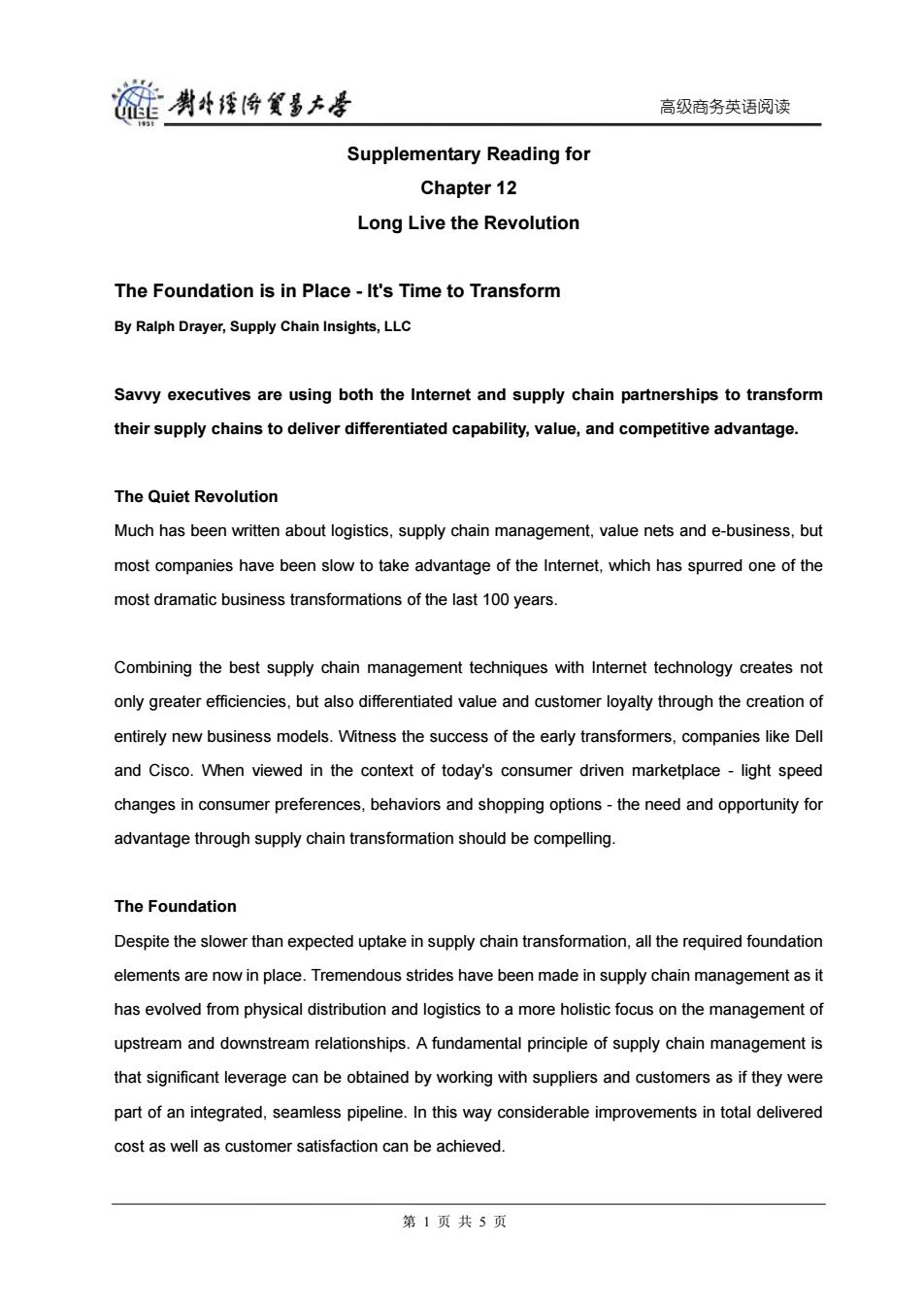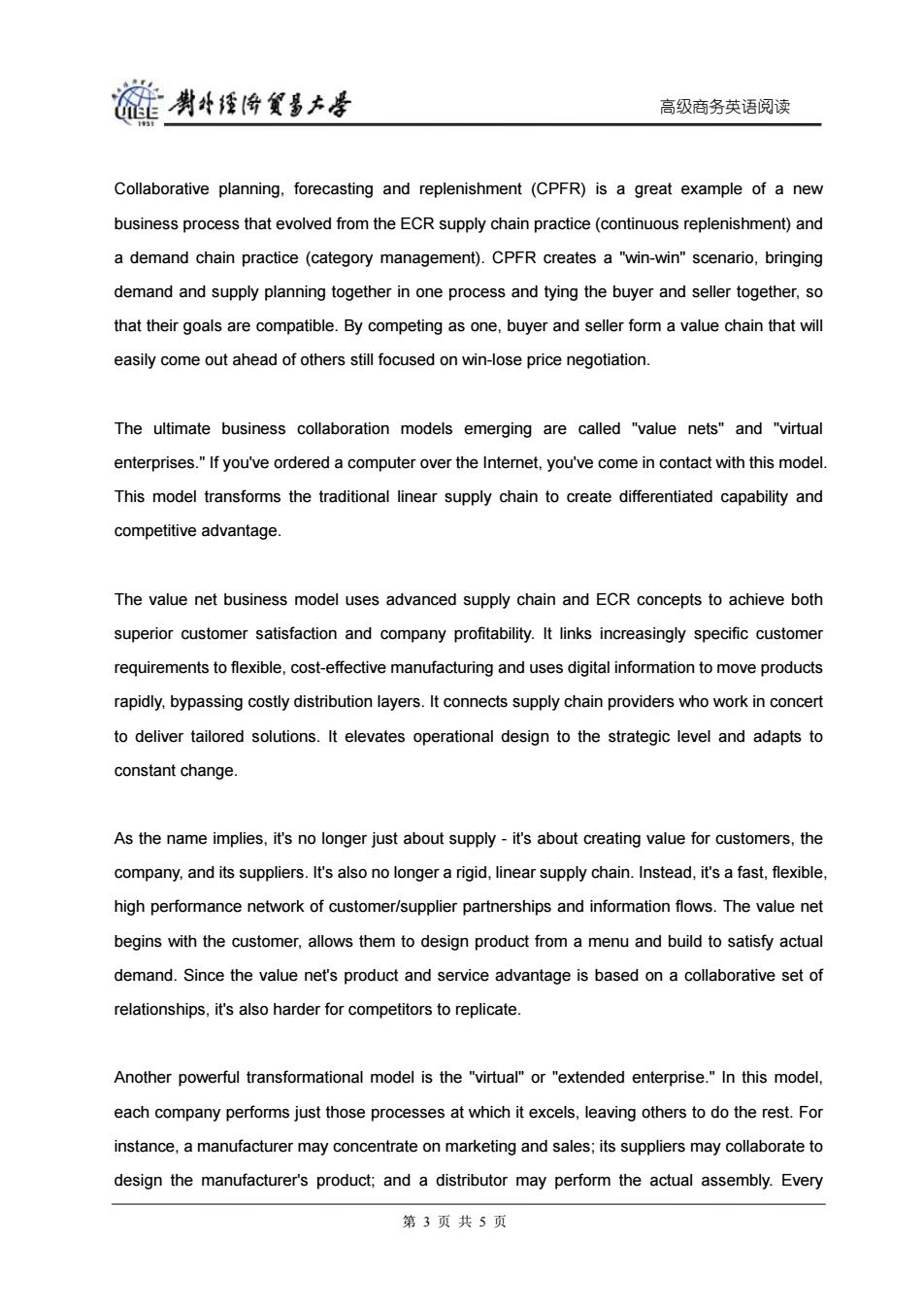
链类4矮降贸多大 高级商务英语阅读 Supplementary Reading for Chapter 12 Long Live the Revolution The Foundation is in Place-It's Time to Transform By Ralph Drayer,Supply Chain Insights,LLC Savvy executives are using both the Internet and supply chain partnerships to transform their supply chains to deliver differentiated capability,value,and competitive advantage. The Quiet Revolution Much has been written about logistics,supply chain management,value nets and e-business,but most companies have been slow to take advantage of the Internet,which has spurred one of the most dramatic business transformations of the last 100 years. Combining the best supply chain management techniques with Internet technology creates not only greater efficiencies,but also differentiated value and customer loyalty through the creation of entirely new business models.Witness the success of the early transformers,companies like Dell and Cisco.When viewed in the context of today's consumer driven marketplace-light speed changes in consumer preferences,behaviors and shopping options-the need and opportunity for advantage through supply chain transformation should be compelling. The Foundation Despite the slower than expected uptake in supply chain transformation,all the required foundation elements are now in place.Tremendous strides have been made in supply chain management as it has evolved from physical distribution and logistics to a more holistic focus on the management of upstream and downstream relationships.A fundamental principle of supply chain management is that significant leverage can be obtained by working with suppliers and customers as if they were part of an integrated,seamless pipeline.In this way considerable improvements in total delivered cost as well as customer satisfaction can be achieved. 第1页共5页
高级商务英语阅读 Supplementary Reading for Chapter 12 Long Live the Revolution The Foundation is in Place - It's Time to Transform By Ralph Drayer, Supply Chain Insights, LLC Savvy executives are using both the Internet and supply chain partnerships to transform their supply chains to deliver differentiated capability, value, and competitive advantage. The Quiet Revolution Much has been written about logistics, supply chain management, value nets and e-business, but most companies have been slow to take advantage of the Internet, which has spurred one of the most dramatic business transformations of the last 100 years. Combining the best supply chain management techniques with Internet technology creates not only greater efficiencies, but also differentiated value and customer loyalty through the creation of entirely new business models. Witness the success of the early transformers, companies like Dell and Cisco. When viewed in the context of today's consumer driven marketplace - light speed changes in consumer preferences, behaviors and shopping options - the need and opportunity for advantage through supply chain transformation should be compelling. The Foundation Despite the slower than expected uptake in supply chain transformation, all the required foundation elements are now in place. Tremendous strides have been made in supply chain management as it has evolved from physical distribution and logistics to a more holistic focus on the management of upstream and downstream relationships. A fundamental principle of supply chain management is that significant leverage can be obtained by working with suppliers and customers as if they were part of an integrated, seamless pipeline. In this way considerable improvements in total delivered cost as well as customer satisfaction can be achieved. 第 1 页 共 5 页

剥好径份贺易大是 高级商务英语阅读 Supply chain management tools,such as continuous replenishment and high-velocity cross-docking,delivered impressive results for customers and suppliers alike and led an entire industry to come together to develop more efficient supply chain practices.Launched in 1993, efficient consumer response(ECR)has changed the whole trading partner focus from adversarial "win-lose"negotiation to collaborative trading relationships.Focus is on removing inefficiencies from the total supply chain and delivering higher consumer satisfaction and value.Perhaps most importantly,ECR built trust and demonstrated the value of deeper collaboration,preparing these companies to fully leverage the powerful capabilities of the Internet. Supply chain transparency and real-time interaction with all trading partners became a reality with the arrival of the Internet.The Internet allows unprecedented,seamless and continuous exchanges across the supply chain.Significant efficiencies can be gained through linking the supply chain and removing unnecessary inventory,variation,cost and reducing cycle times to create an "extended enterprise."In an extended enterprise environment,the sharing of information leads to commonality of goals,increased velocity of trade and meshing of business processes. Because the Internet is a more robust commerce platform,it shifts the emphasis from simply connecting partners,which is mostly transaction-oriented,to coordinating inter-business processes, which is more knowledge and process oriented,and synchronization at this level creates more value. The Opportunity The real payoff from these three critical foundation elements-supply chain management,efficient consumer response and the Internet-is enabling business collaboration.Collaboration occurs when companies work together for mutual benefit;companies leverage each other on an operational basis so that together they perform better than they could separately.Collaboration can occur all along the value chain from design collaboration,through procurement and final distribution.This allows companies sharing information to dramatically shorten processing time, eliminate value-depleting activities and improve quality,accuracy and asset productivity.The overriding goal is to optimize the end-to-end supply chain for the benefit of the end consumer. 第2页共5页
高级商务英语阅读 Supply chain management tools, such as continuous replenishment and high-velocity cross-docking, delivered impressive results for customers and suppliers alike and led an entire industry to come together to develop more efficient supply chain practices. Launched in 1993, efficient consumer response (ECR) has changed the whole trading partner focus from adversarial "win-lose" negotiation to collaborative trading relationships. Focus is on removing inefficiencies from the total supply chain and delivering higher consumer satisfaction and value. Perhaps most importantly, ECR built trust and demonstrated the value of deeper collaboration, preparing these companies to fully leverage the powerful capabilities of the Internet. Supply chain transparency and real-time interaction with all trading partners became a reality with the arrival of the Internet. The Internet allows unprecedented, seamless and continuous exchanges across the supply chain. Significant efficiencies can be gained through linking the supply chain and removing unnecessary inventory, variation, cost and reducing cycle times to create an "extended enterprise." In an extended enterprise environment, the sharing of information leads to commonality of goals, increased velocity of trade and meshing of business processes. Because the Internet is a more robust commerce platform, it shifts the emphasis from simply connecting partners, which is mostly transaction-oriented, to coordinating inter-business processes, which is more knowledge and process oriented, and synchronization at this level creates more value. The Opportunity The real payoff from these three critical foundation elements - supply chain management, efficient consumer response and the Internet - is enabling business collaboration. Collaboration occurs when companies work together for mutual benefit; companies leverage each other on an operational basis so that together they perform better than they could separately. Collaboration can occur all along the value chain from design collaboration, through procurement and final distribution. This allows companies sharing information to dramatically shorten processing time, eliminate value-depleting activities and improve quality, accuracy and asset productivity. The overriding goal is to optimize the end-to-end supply chain for the benefit of the end consumer. 第 2 页 共 5 页

能男华经降贸多大星 高级商务英语阅读 Collaborative planning,forecasting and replenishment (CPFR)is a great example of a new business process that evolved from the ECR supply chain practice(continuous replenishment)and a demand chain practice(category management).CPFR creates a "win-win"scenario,bringing demand and supply planning together in one process and tying the buyer and seller together,so that their goals are compatible.By competing as one,buyer and seller form a value chain that will easily come out ahead of others still focused on win-lose price negotiation. The ultimate business collaboration models emerging are called "value nets"and "virtual enterprises."If you've ordered a computer over the Internet,you've come in contact with this model. This model transforms the traditional linear supply chain to create differentiated capability and competitive advantage. The value net business model uses advanced supply chain and ECR concepts to achieve both superior customer satisfaction and company profitability.It links increasingly specific customer requirements to flexible,cost-effective manufacturing and uses digital information to move products rapidly,bypassing costly distribution layers.It connects supply chain providers who work in concert to deliver tailored solutions.It elevates operational design to the strategic level and adapts to constant change. As the name implies,it's no longer just about supply-it's about creating value for customers,the company,and its suppliers.It's also no longer a rigid,linear supply chain.Instead,it's a fast,flexible, high performance network of customer/supplier partnerships and information flows.The value net begins with the customer,allows them to design product from a menu and build to satisfy actual demand.Since the value net's product and service advantage is based on a collaborative set of relationships,it's also harder for competitors to replicate. Another powerful transformational model is the "virtual"or "extended enterprise."In this model, each company performs just those processes at which it excels,leaving others to do the rest.For instance,a manufacturer may concentrate on marketing and sales;its suppliers may collaborate to design the manufacturer's product;and a distributor may perform the actual assembly.Every 第3页共5页
高级商务英语阅读 Collaborative planning, forecasting and replenishment (CPFR) is a great example of a new business process that evolved from the ECR supply chain practice (continuous replenishment) and a demand chain practice (category management). CPFR creates a "win-win" scenario, bringing demand and supply planning together in one process and tying the buyer and seller together, so that their goals are compatible. By competing as one, buyer and seller form a value chain that will easily come out ahead of others still focused on win-lose price negotiation. The ultimate business collaboration models emerging are called "value nets" and "virtual enterprises." If you've ordered a computer over the Internet, you've come in contact with this model. This model transforms the traditional linear supply chain to create differentiated capability and competitive advantage. The value net business model uses advanced supply chain and ECR concepts to achieve both superior customer satisfaction and company profitability. It links increasingly specific customer requirements to flexible, cost-effective manufacturing and uses digital information to move products rapidly, bypassing costly distribution layers. It connects supply chain providers who work in concert to deliver tailored solutions. It elevates operational design to the strategic level and adapts to constant change. As the name implies, it's no longer just about supply - it's about creating value for customers, the company, and its suppliers. It's also no longer a rigid, linear supply chain. Instead, it's a fast, flexible, high performance network of customer/supplier partnerships and information flows. The value net begins with the customer, allows them to design product from a menu and build to satisfy actual demand. Since the value net's product and service advantage is based on a collaborative set of relationships, it's also harder for competitors to replicate. Another powerful transformational model is the "virtual" or "extended enterprise." In this model, each company performs just those processes at which it excels, leaving others to do the rest. For instance, a manufacturer may concentrate on marketing and sales; its suppliers may collaborate to design the manufacturer's product; and a distributor may perform the actual assembly. Every 第 3 页 共 5 页

喇牛煙将多大是 高级商务英语阅读 participant in the virtual enterprise has a common focus:delivering the greatest possible value to the final customer at the lowest possible cost to the enterprise.To achieve this objective, information must be shared,redundancy eliminated,and opportunities for collaboration exploited. This,in turn,requires unprecedented cooperation,enterprise-wide planning,alignment around common goals,and an inclusive culture. The Challenge The value net and virtual enterprise models offer dramatic improvement in performance but also demand radical changes in thinking and behavior.The key is good business process integration and customer focus.This requires clear consumer value identification of the business problem or opportunity;thinking externally and viewing your extended supply chain as a strategic differentiator; changing organizational structures-multifunctional and horizontal process teams,high commitment work systems and flexible structures that can be easily modified.Traditional patterns of suspicion and mistrust must also give way to openness and sharing.Collaboration is to be expected and rewarded.Finally,senior management leadership is critical to create the capacity for change and environment for success In preparing for the transformation to the e-business world,companies progress through four stages of supply chain competence: 1.Internal supply chain optimization-a new organizational structure,metrics and internal communication system. 2.Network formation-beginning to work with partners and customers,removing barriers and sharing information. 3.Value network formation-extensive use of extranets,collaborative planning and design,and some process integration. 4.Virtual enterprise-full network connectivity with the company as the nucleus of the extended enterprise. Summary The successful companies of tomorrow will use the Internet to collaborate with supply chain partners,which will create new revenue opportunities and achieve new levels of efficiency, 第4页共5页
高级商务英语阅读 participant in the virtual enterprise has a common focus: delivering the greatest possible value to the final customer at the lowest possible cost to the enterprise. To achieve this objective, information must be shared, redundancy eliminated, and opportunities for collaboration exploited. This, in turn, requires unprecedented cooperation, enterprise-wide planning, alignment around common goals, and an inclusive culture. The Challenge The value net and virtual enterprise models offer dramatic improvement in performance but also demand radical changes in thinking and behavior. The key is good business process integration and customer focus. This requires clear consumer value identification of the business problem or opportunity; thinking externally and viewing your extended supply chain as a strategic differentiator; changing organizational structures-multifunctional and horizontal process teams, high commitment work systems and flexible structures that can be easily modified. Traditional patterns of suspicion and mistrust must also give way to openness and sharing. Collaboration is to be expected and rewarded. Finally, senior management leadership is critical to create the capacity for change and environment for success. In preparing for the transformation to the e-business world, companies progress through four stages of supply chain competence: 1. Internal supply chain optimization- a new organizational structure, metrics and internal communication system. 2. Network formation- beginning to work with partners and customers, removing barriers and sharing information. 3. Value network formation- extensive use of extranets, collaborative planning and design, and some process integration. 4. Virtual enterprise- full network connectivity with the company as the nucleus of the extended enterprise. Summary The successful companies of tomorrow will use the Internet to collaborate with supply chain partners, which will create new revenue opportunities and achieve new levels of efficiency, 第 4 页 共 5 页

雒剥经降置昌大是 高级商务英语阅读 customer loyalty,and customer satisfaction.The message,then,is for companies to start building on and leveraging the transformational foundation now in place-it's time. 第5页共5页
高级商务英语阅读 customer loyalty, and customer satisfaction. The message, then, is for companies to start building on and leveraging the transformational foundation now in place - it's time. 第 5 页 共 5 页